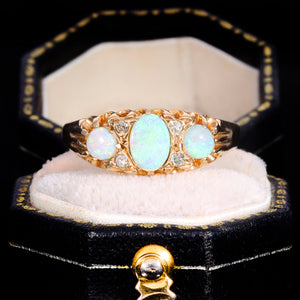Few gemstones capture the imagination quite like the opal. Known for its mesmerising play-of-colour and ethereal glow, the opal has long been cherished for its beauty, mystery, and symbolism. As the birthstone of October, it holds a special place in both history and the world of antique and vintage jewellery.
What Makes Opal Unique?
Unlike most gemstones that owe their colour to chemical composition, opals are defined by their structure. Tiny silica spheres within the stone diffract light, creating a phenomenon known as “play-of-colour”. This natural iridescence produces flashes of rainbow hues that dance across the gem’s surface, making every opal completely unique.
Because of this, opals were often regarded as “living” stones — their changing colours symbolising emotion, passion, and creativity.
The History and Lore of Opal
The opal’s history stretches back thousands of years. The Romans prized it as a symbol of hope and purity, while the ancient Greeks believed opals granted foresight and protection. During the Middle Ages, the opal was thought to bring good fortune to its wearer, especially if they were born in October.
In the 19th century, Queen Victoria helped revive the gemstone’s popularity. She adored opals, often gifting them to friends and family. This royal endorsement led to opals being widely used in Victorian and Edwardian rings, frequently paired with diamonds or pearls for a soft, romantic look.
Where Are Opals Found?
Today, most of the world’s precious opals come from Australia, with famous fields such as Lightning Ridge, Coober Pedy, and Andamooka producing some of the most vibrant stones ever discovered. Other varieties — such as Ethiopian and Mexican opals — are also highly sought after for their distinctive tones and patterns.
Why Opals Are Perfect for Antique Jewellery
Opals were especially popular during the Victorian and Art Nouveau eras, when jewellery design celebrated natural forms and flowing lines. Their soft iridescence suited romantic designs perfectly, often set into ornate gold rings with delicate engraving or scrollwork.
In antique and vintage rings, opals often symbolised hope and loyalty — a reflection of their shifting, luminous beauty. Each antique opal piece carries not just charm, but a glimpse into the era that shaped it.
How to Care for Opal Jewellery
Opal ranks between 5.5 and 6.5 on the Mohs hardness scale, making it softer than many gemstones. To protect your opal jewellery:
- Store it separately in a soft pouch or lined box.
- Avoid exposure to heat or chemicals.
- Clean gently with a damp cloth — never ultrasonic or steam cleaners.
With the right care, an opal ring can remain radiant for generations, preserving both its history and allure.
A Gem for October and Beyond
Whether you’re drawn to opals for their shifting colours, their romantic heritage, or their place in October’s lore, these gemstones remain one of nature’s most enchanting creations. Antique opal rings, with their timeless beauty and craftsmanship, are perfect keepsakes for those who appreciate jewellery with a story.


